Piqued by poké

Keeping up-to-date with the latest Instagram-friendly food trends is vital for any retailer who wants to thrive in foodservice. With that in mind, Cailyn O’Shea took to the streets of Dublin to explore the emerging trend of Hawaiian poké bowls
15 June 2018
A perfect fit
The emerging fast-food craze taking Dublin by storm may not be the McDonalds or KFC that certainly comes to mind at the initial utterance of the phrase ‘fast-food’. Instead, a new, healthier fast-food alternative known as poké bowls, is taking to the bustling Dublin streets and satisfying hungry customers looking for a guilt-free meal.
If you’ve visited Los Angeles or London then you have probably heard of the eye-catching, brightly-coloured bowl of chopped raw fish adorned with a seemingly endless choice of toppings. While many food trends lose the interest of customers and become outdated in the blink of an eye, the poké bowl seems to fit all of the characteristics necessary to thrive in Ireland.
Clean eating
For one, modern society is continuously looking for ways to improve their diets and trim their waistlines. Of course, few are willing to sacrifice taste for health in the process. At the same time that customers are looking for guilt-free foods, retailers of course are looking for sensible menu items that are both appetising and practical.
The simplicity of a poké bowl makes it both easy to assemble, as well as manageable in the kitchen. Since poké bowls primarily handle raw fish, vegetables and fruit, no ovens are necessary which avoids the mess of a potentially greasy kitchen.
Easy on the eye
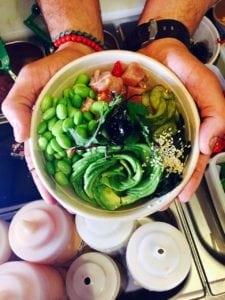 Another massive factor that determines the success of a new food trend is the aesthetics. Poké bowls appeal to both the naked eye and our camera lenses. Nobody wants to post an Instagram snap that looks like a meal was picked up out of the bin and tossed on a plate. Millennials are looking for foods that stand out in a newsfeed of hundreds of other pictures and spark the curiosity of their followers. There is no better way to achieve this goal than with an aesthetically pleasing poké bowl. Its ornamental toppings, both savoury and sweet, allow for a wide assortment of colourful foods, ranging anywhere from edamame and watermelon radish to pomegranate and pineapple.
Another massive factor that determines the success of a new food trend is the aesthetics. Poké bowls appeal to both the naked eye and our camera lenses. Nobody wants to post an Instagram snap that looks like a meal was picked up out of the bin and tossed on a plate. Millennials are looking for foods that stand out in a newsfeed of hundreds of other pictures and spark the curiosity of their followers. There is no better way to achieve this goal than with an aesthetically pleasing poké bowl. Its ornamental toppings, both savoury and sweet, allow for a wide assortment of colourful foods, ranging anywhere from edamame and watermelon radish to pomegranate and pineapple.
Eating a poké bowl is one way to ‘taste the rainbow’ that doesn’t spike your blood sugar. In addition, the ability to personalise one’s own poké bowl, with a choice of grain, raw fish/tofu, and toppings, feeds into today’s culture of customisation. With vastly different likes and dislikes, food allergies, and dietary restrictions, customisable foods are one way to ensure that all customers are content.
Breaking tradition
Although customisation is a massive attraction to poké bowls in today’s food market, interestingly enough, the colourful poké bowls did not originate as the ornamental pieces of art for which they are currently known. Poké bowls are native to Hawaii, and are traditionally just seasoned raw fish – no long-winded list of toppings and dressings. While some Hawaiian natives perceive the new version of poké as warping traditional dishes, others believe that the evolution of a poké bowl is necessary to adapt to constantly changing tastes and customer demand.
Meet the poké pioneers
Ultimately, there is no better way to understand the success of the poké bowl industry than by talking to Dublin retailers who specialise in poké. Klaw Poké, Shaka Poké and Cocu Kitchen were among the first retailers to put their necks on the line and pave the way for the poké market in Dublin, even before the average Dublin native knew what poké was.
Klaw Poké
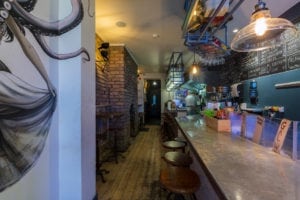
Klaw Poké on Dublin’s Capel Street introduces new customers to the concept of poké every day
Upon entering Klaw Poké on Capel Street, owner and head chef Niall Sabongi greeted ShelfLife with a wide friendly smile. With top pop hits playing in the background, we felt immediately at home amidst a chic poké bar with stylish rustic accents. Just minutes into our conversation, it became clear that for Sabongi, poké is much more than a way of making a living. Rather, Sabongi describes it as a “vehicle to get people to start eating more seafood,” as he feels that the abundant seafood market available to the island of Ireland is being underutilised.
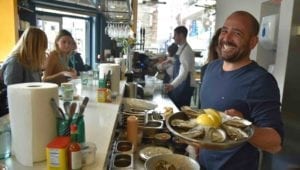
Niall Sabongi
When asked how the poké industry has grown thus far, Sabongi enthusiastically explains that there is still much room for growth and increased awareness. “Every day we are still introducing people to the idea of what poké is,” he says. “It’s still very much a growth thing; people still don’t fully know what it is.” Looking toward the future, Sabongi hopes to expand to many more locations, but also to downsize the size of new shops so that poké is “more of a grab-and-go option, as simple as [picking up] a salad”.
When talking to Sabongi, you can hear the genuine passion and excitement he has for the industry moving forward. He makes it very clear that poké bowls are “a trend, not a fad”. He foresees a future in which a poké bowl can become “as quick and easy as take-away sushi, pre-packaged”. Not only does Sabongi see poké bowls as becoming increasingly convenient to customers, but he also welcomes the arrival of more competitors to the market, seeing them as just another way of getting the word out about poké and leading to a more prevalent healthier lifestyle.
Shaka Poké
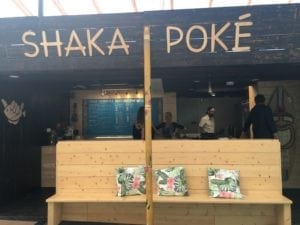 Deep within the Blackrock Market, entering Shaka Poké transports you to the shores of Hawaii, a vacation destination. Surrounded by dozens of other small market booths, Shaka Poké has a distinctive island-feel, from the surfboard greeting you when you enter, to the tropical music playing in the background.
Deep within the Blackrock Market, entering Shaka Poké transports you to the shores of Hawaii, a vacation destination. Surrounded by dozens of other small market booths, Shaka Poké has a distinctive island-feel, from the surfboard greeting you when you enter, to the tropical music playing in the background.
Along with his business partner and co-founder of Shaka Poké Dave McParland, Jamie Haughton learned about poké bowls from travelling to California. From this encounter, Haughton and his love for poké bowls seemed to be love at first sight. “[A poké bowl] looks amazing, tastes amazing, makes you feel really good after, and is very light.” The two partners’ love for poké “stuck” and they immediately started brainstorming for a poké shack.
Having only opened up their permanent poké shack location this past February, Haughton explains that while he has plans for future growth, he also wants to focus on their current facilities. Though they have plans to expand, they “don’t know if that means multiplying setups or trying to enhance the shop”.
When asked how the poké industry has developed so far and its presence going forward into the future, Haughton described the vast change from poké being completely unknown to gaining immense popularity. “I think we’re becoming a lot more diverse,” he says. “Not just in Dublin, but worldwide, just because it’s easier to travel and take ideas [from other places].” Haughton believes that “there are still a lot of people who don’t know what [poké] is and don’t realise how much they will love this dish”. Ultimately, he is imploring those who have not tried the dish to step outside of their comfort zone and give it a go because, in his own words, “poké is here to stay”.
Cocu Kitchen
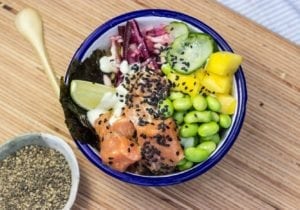 Unlike Klaw Poké and Shaka Poké which specialise primarily in poké bowls, Emily Rowan, head chef and co-founder of Cocu Kitchen, decided to take a different path of incorporating poké into an already existing menu of many diverse items. From exploring the Cocu Kitchen website (www.cocu.ie), it becomes crystal clear how well the poké trend fits into the lifestyle that Cocu advocates. Cocu Kitchen orients itself around the idea of “quality food and a desire to eat healthy, while maintaining a busy lifestyle”. This couldn’t fit more accurately into the subset of clean eating that poké bowls embody.
Unlike Klaw Poké and Shaka Poké which specialise primarily in poké bowls, Emily Rowan, head chef and co-founder of Cocu Kitchen, decided to take a different path of incorporating poké into an already existing menu of many diverse items. From exploring the Cocu Kitchen website (www.cocu.ie), it becomes crystal clear how well the poké trend fits into the lifestyle that Cocu advocates. Cocu Kitchen orients itself around the idea of “quality food and a desire to eat healthy, while maintaining a busy lifestyle”. This couldn’t fit more accurately into the subset of clean eating that poké bowls embody.
After travelling to London and trying a poké bowl for the first time, what appealed to Rowan most was the health benefits as well as the vast array of textures and flavours that the poké bowl contains. The icing on top of the cake was the added feature of the bright and bold colours found in the many ingredients of the poké bowl.
When asked about potential areas for the growth of poké on her menu, Rowan explains how she “might just put a twist on our current [poké bowl] or introduce another one” because they currently only sell the salmon bowl with a tofu alternative. She is hoping to push for a vegan bowl and is currently looking at many different kinds of tofu products that could jazz up her existing tofu bowl.
Even though there are other shops that have a more diverse menu of poké, Rowan isn’t too worried about the potential impact on her shop. “We want to do our poké bowl as best as we can do it,” she says. “That’s our philosophy for everything.” Plus, customer demand shows that the business is selling out of poké bowls every day. Rowan explains how she initially tried to make poké bowls seasonal since they are more generally perceived as a summer option, but when she tried to take it off the menu, customers urged for it to be reinstated. The people of Dublin have spoken and they want their poké bowls all year round!



 Print
Print

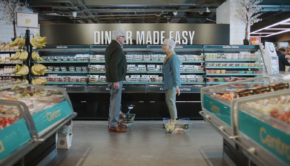
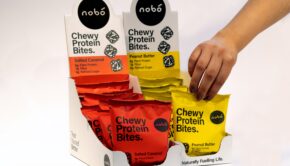
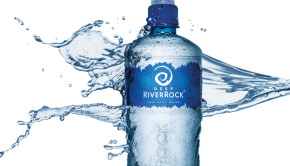


Fans 0
Followers